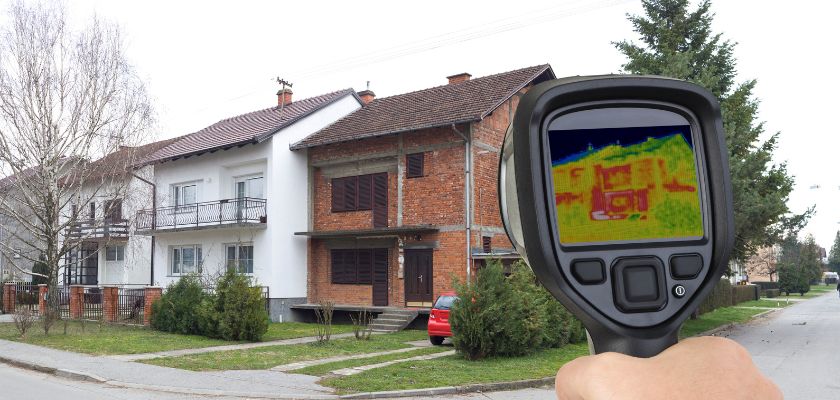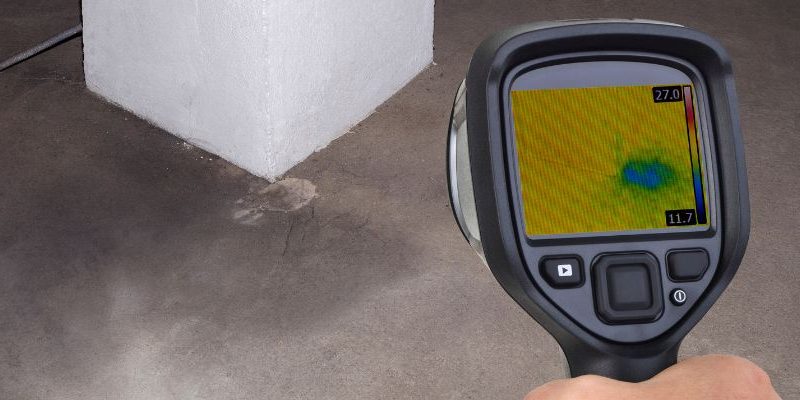In today’s world, the plumbing industry has undergone significant advancements, making leak detection more efficient, accurate, and less invasive. Gone are the days when identifying leaks required tearing down walls or digging up yards. With the advent of modern tools and technologies, professionals can now pinpoint the exact location of a leak with minimal disruption. This article will delve into the top tools and technologies used in modern leak detection, highlighting their benefits and applications.
Acoustic Leak Detectors

Acoustic leak detection is one of the most widely used methods for identifying leaks in pipelines. This technology relies on listening for the sound of water escaping from a pipe. The process involves using sensitive microphones and headphones to detect the noise generated by water escaping under pressure.
How Acoustic Leak Detectors Work
Acoustic leak detectors work by amplifying the sound of water escaping from a pipe. Technicians place sensors along the pipeline and listen for the distinctive sound of a leak. The technology can differentiate between the sound of water flowing normally and the sound of a leak, making it easier to locate the exact position of the problem.
Applications of Acoustic Leak Detection
This method is particularly effective in urban areas where there is a network of pipelines. It is used for regular leak inspections, helping to prevent water waste and damage to properties. Acoustic leak detectors are also beneficial in detecting leaks in underground pipes, where visual inspection is not possible.
Advantages of Acoustic Leak Detectors
The primary advantage of acoustic leak detectors is their non-invasive nature. There’s no need to dig up pipes or break through walls to find a leak. Moreover, this technology is highly accurate, ensuring that the leak location and repair in Frisco, TX, and other regions, can be carried out swiftly and efficiently.
Infrared Thermography

Infrared thermography is another modern tool that has revolutionized leak detection. It works by detecting temperature variations on the surface of walls, floors, and ceilings. These variations can indicate the presence of moisture, which is often a sign of a hidden leak.
How Infrared Thermography Works
Infrared cameras capture thermal images of an area. These images show the temperature distribution on surfaces. When there’s a leak, the area around it tends to be cooler or warmer than the surrounding area, depending on the nature of the leak. By analyzing these images, technicians can identify the exact location of a leak.
Applications of Infrared Thermography
Infrared thermography is particularly useful in detecting leaks in inaccessible areas, such as behind walls or under floors. It is commonly used in regular leak inspections to spot potential problems before they cause significant damage. This technology is also employed in large industrial settings, where manual inspection would be time-consuming and impractical.
Advantages of Infrared Thermography
The key benefit of infrared thermography is its ability to detect leaks without any physical intrusion. It provides a visual representation of the problem area, making it easier for technicians to plan the repair process. Additionally, it can be used to inspect large areas quickly, making it ideal for both residential and commercial properties.
Correlators
Correlators are advanced electronic devices used to detect leaks in water distribution systems. They work by analyzing the sound waves generated by a leak. By comparing the sound waves at two different points on a pipe, correlators can determine the exact location of the leak.
How Correlators Work
Correlators are placed at two points on a pipeline, and the sound of the leak is recorded at both locations. The device then analyzes the time difference between the sounds reaching each point. This information is used to calculate the precise location of the leak. The use of correlators is especially beneficial for detecting leaks in long pipelines.
Applications of Correlators
Correlators are widely used in municipal water systems and large commercial properties. They are particularly useful for leak location and repair in Frisco, TX, where extensive pipeline networks need to be regularly monitored for leaks. This technology is also used in detecting leaks in pipelines running through difficult terrain or buried deep underground.
Advantages of Correlators
The primary advantage of correlators is their accuracy. They can pinpoint the location of a leak within a few feet, even in large and complex pipeline systems. This reduces the time and effort required for leak detection and allows for quicker repairs, minimizing water loss and potential damage.
Ground Penetrating Radar (GPR)
Ground Penetrating Radar (GPR) is a non-invasive technology used to detect leaks in buried pipelines. It works by sending high-frequency radio waves into the ground and analyzing the reflected signals to detect any anomalies, such as a leak.
How Ground Penetrating Radar Works
GPR equipment consists of a transmitter and a receiver. The transmitter sends radio waves into the ground, and the receiver picks up the reflected signals. Any changes in the signals can indicate the presence of a leak. GPR is particularly effective in detecting leaks in pipelines buried under concrete, asphalt, or soil.
Applications of Ground Penetrating Radar
GPR is used in various settings, including residential, commercial, and municipal properties. It is especially useful in regular leak inspections of underground pipelines, where traditional detection methods might not be feasible. GPR is also employed in construction projects to ensure that existing pipelines are not damaged during excavation.
Advantages of Ground Penetrating Radar
The key advantage of GPR is its ability to detect leaks without any need for excavation. It provides accurate information about the location and depth of a leak, making it easier for technicians to plan the repair process. GPR is also versatile, as it can be used in different types of terrain and soil conditions.
Smart Water Meters
Smart water meters are digital devices that monitor water usage in real-time. They can detect unusual patterns in water consumption, which may indicate a leak. These meters are connected to a central system, allowing for remote monitoring and immediate alerts in case of a leak.
How Smart Water Meters Work
Smart water meters are installed at the point where water enters a property. They continuously monitor water flow and send data to a central system. If the meter detects an unusual spike in water usage, it can trigger an alert, allowing for prompt investigation and repair.
Applications of Smart Water Meters
Smart water meters are commonly used in residential properties to help homeowners monitor their water usage and detect leaks early. They are also used in commercial and industrial settings, where large amounts of water are consumed daily. Regular leak inspections using smart meters can prevent water waste and reduce utility bills.
Advantages of Smart Water Meters
The primary advantage of smart water meters is their ability to provide real-time data. This allows for immediate detection and response to leaks, reducing the potential for water damage. Additionally, smart meters can help homeowners and businesses track their water usage and identify areas where they can conserve water.
Electromagnetic Pipe Locators
Electromagnetic pipe locators are devices used to detect underground pipes and the leaks within them. They work by generating an electromagnetic field around the pipe, which is then detected by a receiver. Any disruption in the field can indicate the presence of a leak.
How Electromagnetic Pipe Locators Work
These locators consist of a transmitter and a receiver. The transmitter generates an electromagnetic field around the pipe, and the receiver picks up the field’s signals. If there is a leak, the electromagnetic field will be disrupted, allowing technicians to identify the exact location of the problem.
Applications of Electromagnetic Pipe Locators
Electromagnetic pipe locators are widely used in construction and utility industries to locate underground pipes before excavation. They are also used in regular leak inspections to detect leaks in buried pipelines. This technology is particularly useful in areas with dense underground utility networks.
Advantages of Electromagnetic Pipe Locators
The main advantage of electromagnetic pipe locators is their ability to detect leaks without any need for digging. They provide accurate information about the location of the leak, reducing the time and cost of repairs. Additionally, these locators can be used to map out underground utility networks, preventing accidental damage during construction.
Final Wording
The advancement in leak detection tools and technologies has made it possible to identify and repair leaks with minimal disruption and maximum efficiency. Whether it’s using acoustic leak detectors, infrared thermography, or smart water meters, each method offers unique benefits that contribute to preserving our water resources and preventing damage to properties. Regular leak inspections using these modern tools ensure that any issues are caught early, allowing for prompt leak location and repair in Frisco, TX, and beyond. With the right tools and technologies, leak detection has become a precise and less invasive process, ultimately saving time, money, and water.
FAQ’s
1. What are the benefits of using acoustic leak detectors for finding leaks in my home?
Acoustic leak detectors offer a non-invasive way to locate leaks by detecting the sound of water escaping from pipes. This technology allows for precise leak detection without needing to break through walls or dig up floors, saving both time and money on repairs.
2. How does infrared thermography help in detecting hidden leaks?
Infrared thermography uses thermal imaging to identify temperature variations on surfaces. These variations often indicate moisture, helping technicians pinpoint leaks behind walls or under floors without any physical damage to the property.
3. Can smart water meters detect leaks in real-time?
Yes, smart water meters monitor water usage in real-time and can detect unusual patterns that may indicate a leak. They can send immediate alerts to property owners, allowing for quick action to prevent water damage and excessive water bills.
4. What makes correlators effective for detecting leaks in large pipelines?
Correlators analyze the sound waves generated by leaks at different points along a pipeline. This technology can accurately locate leaks over long distances, making it ideal for large-scale water distribution systems.
5. Is Ground radar (GPR) suitable for detecting leaks in urban areas?
Absolutely, Ground Penetrating Radar (GPR) is particularly effective in urban environments where pipelines are buried under concrete, asphalt, or dense soil. It detects leaks without the need for excavation, minimizing disruption in busy areas.







